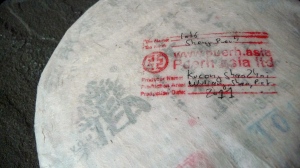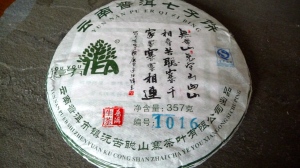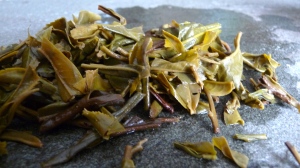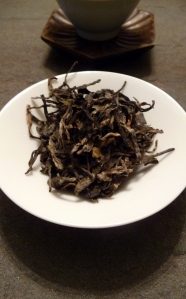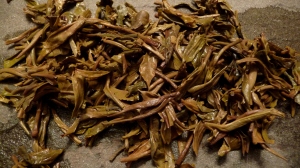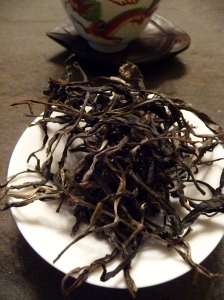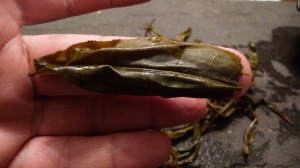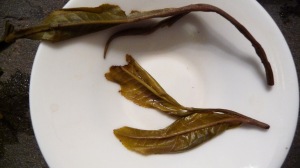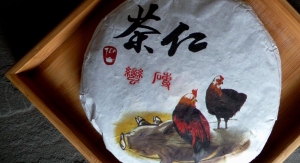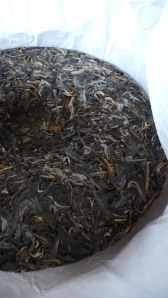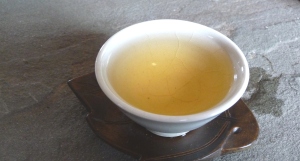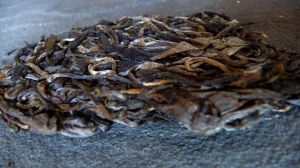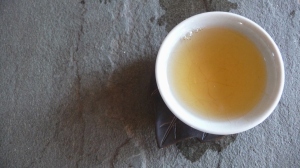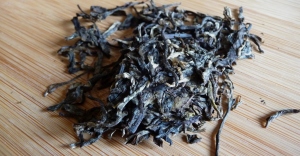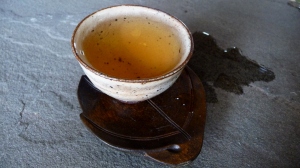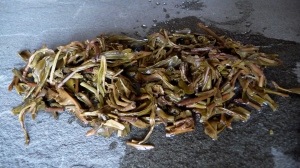With the sudden flush of Nan Nuo puerh I found myself in the company of –following receipt of a 2012 Zhi Zheng.Song Nan Nuo Zi Di cake sample. I thought it was time to tackle the comparative review.
The three teas in question:
–2012 Zhi Zheng.Song Nan Nuo ‘Ji Di’
–2011 Essence Of Tea NanNuo (sourced near Douizhai)
–2012 NanNuo Qing Mian brick sold by Bana Tea
I wasn’t initially certain if it was fair to compare the EoT and ZZ.S as they were from different years. However, as they shared some similar characteristics, it seemed relatively acceptable. Do take this year variation into consideration when reading the observations.
First, the Zhi Zheng.Song.

The nose of the dry leaf was fresh, flush with the inevitable scents of meadow often found in young puerh. Placing the leaves into the warmed pot provoked intensification of the aroma, further rounded out by a gentle sweetness, nestled deep and barely detectable.
As the first broth entered the mouth it felt quite vaporous, elusive. That said, it did, however, leave a notable impression in the wake of its descent into the throat. It lingered on the tongue, with a forward focus.

A sweet aromatic clung to the air surrounding the just steeped second broth, and served as foreshadow.
By the second and third steeps bittersweet citrus notes hung gently in the hollow of the mouth. They would fall, pooling, into the pockets behind the lower jaw. The mid-point of the hard palate exhibited a strong focal point of cooling which pushed its way into the sinus cavity.
The sixth and seventh steeps revealed a sticky sweetness at the back of the mouth and entrance to the throat. My brow had become considerably heavy at this point. The core increasingly warm.
Its full flavor profile proved difficult to describe, then and now. A sort of ‘otherness’, with a confounding trait of spice that nags at my brain still.
Approaching the eleventh steeping the mouth feel turned soothing and glossy. The dominant profile became quite ethereal, a series of waxing and waning washes of floral and citrus, and that damned hidden spice.
Sweetness continued to increasingly gather at the back of the mouth. Deep inhalations fill the chest with the soft citrus aromatics. Upon exhalation they pushed out from deep within the throat, and penetrated into the sinus cavity through the soft palate.

The tea’s nature had fully sank into the chest with the 18th steep. I had decided on the purchase of a full cake at this point as it had effectively ticked all the boxes of things I look for in a tea.
We now come to the Essence Of Tea NanNuo sourcing from 2011.
The nose of the dry leaf here was far softer, more like a green tea in its gentleness with highlights of pale woodiness and a streak of citrus.

The softness of this aroma carried over nicely into the sweet grassy profile of the first few steeps. The liquor settled into the mouth with a generously buttery smoothness. Where the Zhi Zheng.Song initially focused forward, this tea focused at the back of the tongue and pockets of the mouth.

A cooling sensation streaked the length of the meeting point of the soft and hard palates, and filled the arch of the soft palate.
Its energy sat at the brow, though not with quite the same strength as noted in the Zhi Zheng.Song.
As the session progressed a glossiness developed in the mouth, as did a slight drying sensation which appeared greatly at the back of the lips. A floral and citrus sweetness began to extend into the throat as I rounded the eighth and ninth steeps. There was also a similar curious spice note suspended in the mouth, once again reluctant to name itself.
The beauty of this tea was the liquor’s density, and its delivery of a heavy sweetness. The latter of which seemed to seep out generously from the corners of the mouth by later steeps.

It was clean, humble, albeit, seemingly a touch one-dimensional. It didn’t evolve as successfully as the younger Zhi Zheng.Song offering, nor was it as expressive in the mouth or body. Could this be the year variable? Or, is it purely the village variable. Regardless, it remains a delicate and beautiful tea.
We now come to the NanNuo Ming Qian offered by Bana Tea.
The nose of the dry, rather fragmented, leaf was closer to the Zhi Zheng.Song. It offered further extensions of faint floral aromatics, and a more pronounced sweetness.

The flavor of the steeped liquor then shifted toward the Essence Of Tea offering; pure, fresh, grassy. It also presented a sweet, soft, buttery sensation that quickly enveloped the mouth. The nature of the tea sent floods of elegant sweetness into the arch of the mouth, pushing gently at the soft palate.

A faint cooling developed in the mouth by the third and fourth steeps. Glossiness was felt, though muted by comparison to the heightened sensation found in both of the previous teas. A notable drying developed at the sides of the tongue and the points of contact at the palate by the fifth and sixth steeps.
And then, in heartbreaking fashion, successive steeps yielded little in the way of texture or movement in the mouth. The body feel was relatively faint. Its’ remaining attribute was the protracted sweetness that returned in the mouth.

It would seem that the chopped nature of the leaf had something to do with its short life in the pot. The leaves unleashed everything within a few quick steeps, and then gave up the ghost. The Young Jade Ming sample previously encountered performed wonderfully by comparison, so perhaps it’s due to the fragile nature of the Nan Nuo characteristics. Whatever the case, it seems like the tea would have otherwise been of note.
This was an enjoyable exploration of three different sourcings from Nan Nuo Shan, with multiple variables, ending with the discovery of a much preferred cake from the bunch.
With Newt now continuously stamping across my keyboard, and swatting at my screen, this post must come to a close.

